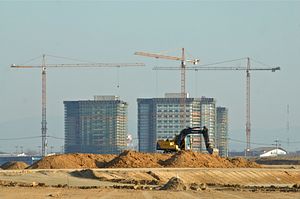With burden-sharing negotiations underway to determine how the United States and South Korea will split the cost of allied military assets on the peninsula, local Korean governments are hoping to kickstart the long, drawn out process of returning unused U.S. military bases for community use.
In 2018, U.S. Forces Korea officially christened its new headquarters at Camp Humphreys in Pyeongtaek, located about 40 miles south of Seoul. While final transfers from other bases are still wrapping up, the majority of U.S. troops have moved down to the new base, and the process should be completed by 2022. The new facility will eventually house an estimated 40,000 troops, personnel and dependents, making it the largest overseas U.S. military base in the world.
The transfer has been in the works since 2004, when the United States and South Korea agreed to start relocating U.S. troops out of increasingly crowded Seoul. Of particular interest is Yongsan Garrison, in the heart of the city, which the Korean government wants to turn into Seoul’s answer to Central Park. The original plan was to move troops out of the city in 2008, but issues with construction kept pushing the date back until last year. South Korea ended up picking up 90 percent of the tab for the $11 billion construction of Camp Humphreys — a point that analysts have asked U.S. President Donald Trump to keep in mind as he presses for more money from his Korean counterparts in the ongoing burden-sharing negotiations.
Meanwhile, local Korean governments are eager to start taking control of the now-empty bases that litter the areas north of the capital. Ahn Byung-young, mayor of Uijeongbu, asked this week for the swift transfer of three former bases in his jurisdiction — Camp Red Cloud, Camp Jackson, and Camp Stanley — into local control. The city has plans to turn the three sites into a security theme park, a culture arts park, and an elderly care facility, respectively. The delayed transfer of the bases “is hampering local development” and exacerbating a regional economic slump,” Mayor Ahn said.
Although these and other bases have been vacated in the big move of troops to Pyeongtaek, full return of the land they occupy is still delayed. Out of the 80 U.S. bases that dotted the peninsula, 54 have already been returned to Korean control and 26, including those in Uijeongbu as well as parts of Yongsan, have not yet been transferred. The delays have been attributed to negotiations over the cost of decontamination and clean-up of the sites in question.
For their part, however, USFK said in a recent press release that 15 of the 26 sites in question — including five parcels of land in Yongsan — are already vacated and ready for transfer at any time. “As a testament to our US-RoK alliance, USFK remains committed to returning installations as expeditiously as possible to RoK government control,” the release said. A USFK spokesman later said they wanted to correct the record and make it clear that the perception that USFK was holding up the process when that is not the case, emphasizing that more than half the remaining pieces of land are ready for transfer.
As discussions over the expedited transfer of the remaining U.S. bases continues, the burden-sharing negotiations will also be front and center in alliance management. After failing to find an agreement earlier this year, the two sides announced a one-year stopgap deal for South Korea to pay 1.04 trillion won ($920 million) for the cost of troops for 2018, an 8 percent increase over their previous annual contribution. Trump has asked the Koreans to increase their contribution to $5 billion a year, more than five times the current level of spending. The allies now have until December 31 to find another agreement for 2019 and beyond.
Jenna Gibson is a doctoral student in political science at the University of Chicago and a Korea blogger for The Diplomat. You can find her on Twitter at @jennargibson.

































